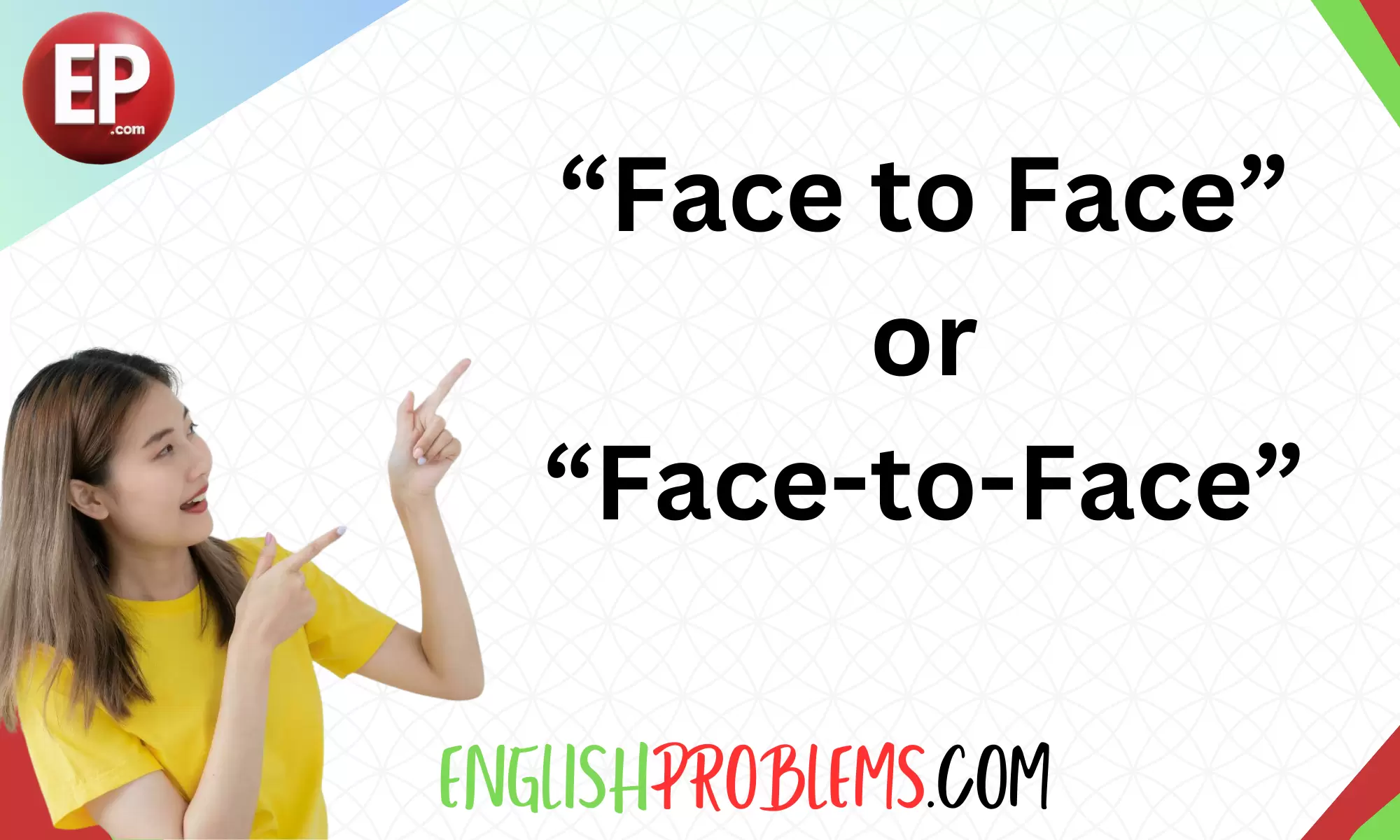Hyphens might seem like small punctuation marks, but they play a significant role in the English language.
Proper hyphenation can change the meaning of phrases, improve readability, and ensure clear communication. One common area of confusion is the phrase “face to face.” Should it be written as “face to face” or “face-to-face“?
This article will delve into the importance of hyphens in American English, when to hyphenate “face to face,” and how to use hyphens correctly in different contexts.
The Importance of Hyphens in American English
What Are Hyphens and Why Are They Used?
Hyphens are punctuation marks used to join words or parts of words. They serve various functions, such as forming compound words, splitting words at the end of lines, and clarifying meaning. In American English, hyphens are essential for:
- Creating Compound Words: Hyphens join two or more words to create a single concept (e.g., well-known, mother-in-law).
- Clarifying Meaning: Hyphens can eliminate ambiguity by clarifying which words are linked (e.g., re-sign vs. resign).
- Improving Readability: Hyphens can make phrases easier to read and understand.
Examples of Hyphen Usage
- Compound Adjectives: She has a well-deserved reputation.
- Compound Nouns: My brother-in-law is visiting.
- Prefixes and Suffixes: The pre-existing condition was noted.
Hyphens ensure that the reader understands the intended meaning and maintains the flow of the text.
When Should You Hyphenate “Face to Face”?
General Rule for Hyphenating Compound Adjectives
The general rule for hyphenating compound adjectives is to hyphenate them when they come before a noun they modify. In the case of “face to face”:
- Hyphenated (adjective before noun): They had a face-to-face meeting.
- Not hyphenated (adjective after noun): They met face to face.
This rule helps in maintaining consistency and clarity in writing.
Exceptions to the Rule
Some exceptions to the hyphenation rule include:
- Commonly Used Phrases: Over time, some compound adjectives become so familiar that the hyphen is dropped (e.g., email instead of e-mail).
- Adverbs Ending in -ly: Adverbs ending in -ly are not hyphenated before adjectives (e.g., highly qualified candidate).
Examples of Correct and Incorrect Usage
- Correct: She prefers face-to-face interactions.
- Incorrect: She prefers face to face interactions.
- Correct: They will discuss the issue face to face.
- Incorrect: They will discuss the issue face-to-face.
These examples illustrate the importance of context in hyphenation.
The Role of Adverbs and Adjectives
Adjectives and Hyphenation
Adjectives modify nouns and often require hyphenation when combined with other words. For example:
- Single-word Adjectives: She wore a blue dress.
- Compound Adjectives: She wore a well-tailored dress.
In the case of “face to face,” the phrase functions as a compound adjective when it precedes a noun, necessitating a hyphen.
Adverbs and Their Impact on Hyphenation
Adverbs describe verbs, adjectives, or other adverbs and can impact hyphenation. However, adverbs ending in -ly do not require hyphens:
- Correct: A beautifully crafted sculpture.
- Incorrect: A beautifully-crafted sculpture.
Clear Examples of Both Scenarios
- Adjective Before Noun: He gave a face-to-face apology.
- Adjective After Noun: He apologized face to face.
These examples demonstrate how the position of the phrase affects hyphenation.
Hyphenation in Different Contexts
Formal Writing
In formal writing, such as academic papers or professional documents, adhering to hyphenation rules is crucial. Consistency and correctness in hyphen usage enhance the credibility and clarity of the text.
Examples of Formal Writing
- Business Reports: The face-to-face interview was scheduled for Monday.
- Academic Papers: The study involved face-to-face interactions between participants.
Informal Writing
In informal writing, such as emails or social media posts, hyphenation rules can be more relaxed. However, using hyphens correctly can still improve readability and comprehension.
Examples of Informal Writing
- Emails: Let’s have a face-to-face chat tomorrow.
- Social Media: I love face-to-face conversations with friends!
Digital Communication
In digital communication, clarity is key. Correct hyphenation can prevent misunderstandings and ensure the message is clear.
Examples of Digital Communication
- Text Messages: Can we have a face-to-face meeting later?
- Online Forums: Face-to-face interactions are more meaningful.
Common Misconceptions About “Face to Face” Hyphenation
Misconceptions
Many writers believe that “face to face” should always be hyphenated or never hyphenated, regardless of context. This misconception can lead to inconsistent and incorrect usage.
Clarifications
To clarify:
- Hyphenate: When “face-to-face” functions as a compound adjective before a noun.
- Do Not Hyphenate: When “face to face” follows the verb or is used as a predicate adjective.
Real-World Examples
- Correct: The face-to-face discussion was productive.
- Incorrect: The face to face discussion was productive.
- Correct: We discussed the matter face to face.
- Incorrect: We discussed the matter face-to-face.
Understanding these rules helps in applying hyphenation correctly.
“Face to Face” in Official Sources and Publications
Style Guides
Major style guides provide guidelines for hyphenation, ensuring consistency across various types of writing. Here are some examples:
- APA Style: Hyphenate compound adjectives before a noun (e.g., face-to-face communication).
- Chicago Manual of Style: Follow the same rule for hyphenation (e.g., face-to-face meeting).
Examples from Books, Articles, and Official Documents
- Books: In her book, she emphasizes the importance of face-to-face meetings.
- Articles: The article highlights the benefits of face-to-face interactions.
- Official Documents: The policy mandates face-to-face evaluations.
Importance of Consistency
Consistency in hyphenation, especially in official sources, maintains professionalism and clarity.
Examining Grammar Rules with Real-World Examples
Detailed Explanation of Relevant Grammar Rules
Grammar rules dictate when and how to use hyphens in compound adjectives. Understanding these rules is essential for correct usage.
- Compound Adjectives: Hyphenate when they come before a noun.
- Adverbs Ending in -ly: Do not hyphenate before adjectives.
Real-World Examples from Various Contexts
- Business: We had a face-to-face negotiation.
- Education: Face-to-face learning is beneficial.
- Healthcare: Face-to-face consultations are necessary.
Analysis of Correct and Incorrect Usages
- Correct: The face-to-face interview went well.
- Incorrect: The face to face interview went well.
- Correct: They talked face to face.
- Incorrect: They talked face-to-face.
Analyzing these examples helps in understanding the practical application of grammar rules.
How Context Affects the Use of “Face-to-face”
Contextual Variations
The context in which “face to face” or “face-to-face” is used can determine whether a hyphen is necessary.
- Formal vs. Informal: Hyphenation rules may vary based on the formality of the writing.
- Different Mediums: The need for hyphens can change depending on whether the text is digital or printed.
Formal vs. Informal
In formal contexts, strict adherence to hyphenation rules is important for clarity and professionalism. In informal contexts, flexibility is allowed, but correct usage is still preferred.
Specific Examples Demonstrating Contextual Differences
- Formal: The face-to-face consultation was critical.
- Informal: We chatted face to face and caught up.
Understanding how context affects hyphenation ensures accurate and effective communication.
Tips for Writing “Face to Face” or “Face-to-face” Correctly
Practical Tips for Writers
Here are some practical tips to help you use “face to face” or “face-to-face” correctly:
- Know the Rule: Remember that “face-to-face” is hyphenated when it functions as a compound adjective before a noun.
- Check Context: Consider the formality and context of your writing.
- Use Resources: Refer to style guides like APA or Chicago for specific guidelines.
- Proofread: Always proofread your work to ensure correct hyphenation.
Common Scenarios and Correct Usage
- Business Emails: “Let’s schedule a face-to-face meeting.”
- Academic Papers: “The study focused on face-to-face interactions.”
- Casual Conversations: “We talked face to face.”
Checklist for Correct Hyphenation
- Is it a compound adjective before a noun? Hyphenate.
- Is it used after the noun or as a predicate adjective? Do not hyphenate.
- Is the context formal or informal? Adjust accordingly.
Conclusion
Summary of Main Points
Hyphens play a crucial role in ensuring clarity and accuracy in writing. Understanding when to hyphenate “face to face” as “face-to-face” is essential for correct usage. By following grammar rules and considering context, writers can effectively communicate their message.
Final Thoughts and Recommendations
Consistency and correctness in hyphenation not only improve readability but also enhance the professionalism of your writing. Always refer to style guides and proofread your work to ensure proper hyphenation.
Call to Action
Practice these hyphenation rules in your writing to improve clarity and communication. Share this article with others who might benefit from understanding the correct use of hyphens.

Dariel Campbell is a language aficionado dedicated to demystifying English problems for learners worldwide. His approachable writing style and thorough explanations turn confusion into clarity. With Dariel’s guidance, mastering the English language becomes a rewarding and empowering experience.


